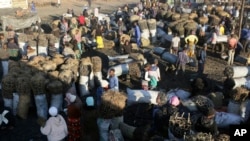Earlier this month, the head of the U.S. Agency for International Development, USAID, told lawmakers that Washington is stepping up efforts to help developing countries struggling with debt and that China is part of the problem.
Testifying before the House Foreign Affairs Committee Samantha Power said that China’s “global lending spree has made it the world’s largest debt collector.”
“For every dollar of aid, it provides to low-income and middle-income countries, China has provided $9 of debt,” she told U.S. lawmakers on April 10.
“The opposite is true of the U.S., Power stated: for every dollar of debt we provide, we provide at least $9 of aid.”
China’s International Development and Cooperation Agency dismissed the accusations as baseless.
“No country has fallen into debt difficulties because of cooperation with China,” Lin Ming, the agency’s spokesperson said on April 18.
This is false.
At least two countries, Zambia and Sri Lanka have gone into default and declared bankruptcy, mainly due to their inability to pay high interest rates on their debts to China. About a dozen developing countries now owe more than 10% of their GDP to China’s state creditors.
In a dozen countries most indebted to China, paying back the debt is “consuming an ever-greater amount of the tax revenue needed to keep schools open, provide electricity and pay for food and fuel,” The Associated Press reports.
China became the world’s largest bilateral lender in 2017. Unlike other economies, China’s overseas loans do not come from the private sector, but from the Chinese government, its state-owned banks, and state-owned enterprises.
China offers terms similar on the surface with most commercial loans but imposes shorter maturities and higher interest rate. For example, the World Bank and the International Monetary Fund generally provide loans to developing countries at rates around 0 to 1.5%. China’s loan interest rates are generally around 2% to 3%.
China’s massive global infrastructure project, the Belt and Road Initiative, has played a pivotal role when it comes to debt traps. Eight years after its launch in 2013, China nearly tripled the maximum penalty interest rate for late repayments: raising it from an initial rate of 3% in 2014-2017 to 8.7% in 2018-2021, according to the Aid Data research lab at William and Mary, a public university in Virginia.
Zambia borrowed from Chinese state-owned banks over the last 20 years to renovate its dams, subway systems and roads. Those funds helped boost Lusaka’s economy but also led to increased foreign interest payments. The government was running low on foreign exchange reserves, and was forced to cut spending on health care, social services and subsidies.
At the end of 2020, Zambia declared bankruptcy. After that announcement, the country’s inflation soared 50%, unemployment hit a 17-year high, and the national currency, Kwacha, lost 30% of its value in seven months.
According to data from the International Monetary Fund, by the end of 2022, Zambia owed nearly 16.8 million dollars in foreign debt, of which $6 billion to China. A breakdown shows that Zambia owes $4.1 billion to China’s the Export-Import Bank and $1.8 billion to other Chinese lenders.
The landlocked country is ready to move on from “a failed economic development model based on borrowing billions of dollars of debt from creditors like China,” the country's finance minister Situmbeko Musokotwane told the Wall Street Journal.
“The level of debt that Zambia acquired from China was way, way too high,” Musokotwane said.
Sri Lanka became the first state in the Asia-Pacific region to enter sovereign default in the 21st century.
On July 5, 2022, Colombo declared bankruptcy due to its inability to pay due debts and interest. Since then, power outages have continued in the country, food prices have skyrocketed, and more than half of the country's citizens have fallen into poverty.
China is the largest bilateral creditor to Sri Lanka, accounting for 43% of Colombo’s total debt as of September 2023. The second and third lenders are Japan (22%) and India (15%) respectively.
China has made several mega-investments in Sri Lanka, including highways, international airports and maritime ports. Among them, the Hambantota International Port and the Mattala Rajapaksa International Airport financed by the Export-Import Bank of China, are seen as White Elephant projects, meaning they are hard to maintain, unprofitable, and impossible to sell.
The Hambantota International Port is a deep-water port and was initially built as part of the 21st Century Maritime Silk Road with financing from China. Unable to repay the loan, Sri Lanka reached an agreement with China in 2017 for a 99-year lease for the port. Many analysts worry that this could become a Chinese naval facility.
China’s state-owned Xinhua News Agency called this “another milestone along (the) path of (the) Belt and Road.”
The Mattala Rajapaksa International Airport was finished in 2012 with mainly Chinese financing: $190 million out of a total of $209 million.
It is a magnificent construction project, with a 12,000 square meter terminal building, 12 check-in counters, two gates, a runway long enough to handle the largest commercial jets, and capacity for one million passengers per year.
The problem is that the airport has failed to attract airlines. By 2018, all airlines had suspended their operation from the airport, which is now officially the world’s emptiest international airport.
Even with these failed endeavors, Sri Lanka approved Sinopec, a Chinese state-owned enterprise, to build a $4.5 billion refinery in the southern port of Hambantota in late 2023. This marks the largest investment in Sri Lanka since the economic crisis started in 2022.






